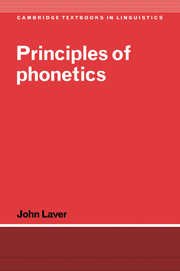Book contents
- Frontmatter
- Contents
- List of figures
- List of tables
- Preface
- Acknowledgements
- Introduction
- PART I General concepts
- PART II The analytic framework
- 4 The phonetic analysis of speech
- 5 The architecture of phonetic classification
- PART III Initiation and phonation
- PART IV Linear segmental analysis
- PART V Articulatory co-ordination and phonetic settings
- PART VI Temporal, prosodic and metrical analysis
- PART VII Principles of transcription
- PART VIII Conclusion
- Envoi
- Appendix I The phonetic alphabet of the International Phonetic Association
- Appendix II Index of languages
- References
- Index of names
- Subject index
4 - The phonetic analysis of speech
Published online by Cambridge University Press: 05 June 2012
- Frontmatter
- Contents
- List of figures
- List of tables
- Preface
- Acknowledgements
- Introduction
- PART I General concepts
- PART II The analytic framework
- 4 The phonetic analysis of speech
- 5 The architecture of phonetic classification
- PART III Initiation and phonation
- PART IV Linear segmental analysis
- PART V Articulatory co-ordination and phonetic settings
- PART VI Temporal, prosodic and metrical analysis
- PART VII Principles of transcription
- PART VIII Conclusion
- Envoi
- Appendix I The phonetic alphabet of the International Phonetic Association
- Appendix II Index of languages
- References
- Index of names
- Subject index
Summary
The aim of the first three chapters has been to discuss the nature of spoken communication. A broad framework has been offered for the analysis of speech in general, within which the analysis of those facets of speech that serve to carry spoken language can be set. In this framework, the role of general phonetic theory is to describe and explain the relationship between the medium of speech and the formal code of spoken language. We have seen that this relationship is semiotically rich and complex, and that speech is a vehicle for considerably more information than simply the symbolic communication of spoken language. However, it remains true that the principal traditional focus of general phonetic theory is to provide an objective description of the speech material underlying the contrastive and contextual patterns which constitute spoken language.
The task of this chapter is to give some consideration to the scope and coverage of a general phonetic theory, and to the initial identification of the types of analytic unit that might be recruited for the objective description of the phenomena of speech, especially those of spoken language.
General phonetic theory and general phonological theory
The purpose of the next thirteen chapters is to develop a descriptive vocabulary for a general phonetic theory that addresses this primary linguistic task, and which can also be extended to the task of describing paralinguistic and extralinguistic events in speech.
- Type
- Chapter
- Information
- Principles of Phonetics , pp. 95 - 118Publisher: Cambridge University PressPrint publication year: 1994



